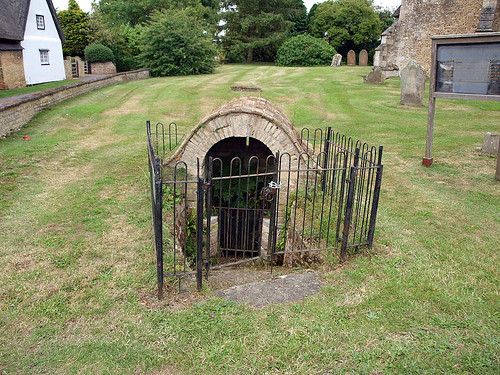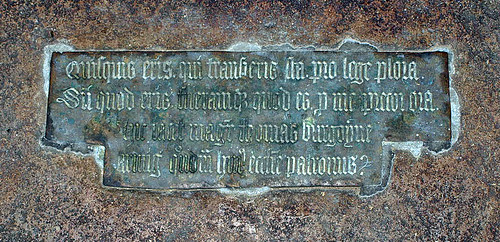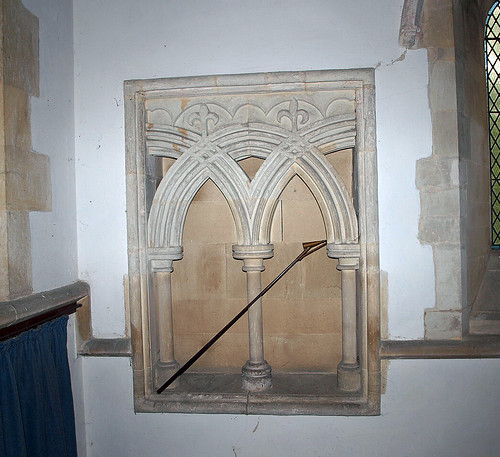ST MICHAEL. A very remarkable little church mostly of c. 1230, though the chancel was rebuilt (correctly) in 1884. The most interesting and impressive feature is the W front with buttresses at the angles but also two big buttresses running up the middle with three set-offs to the original twin bell-cote. The roof reaches down so low on the sides of the arches that the windows are very small. The chancel is higher and has lancet windows in the sides and a group of three stepped single lancets at the E end. Inside, the chancel has hood-moulds for the windows and a beautiful Double Piscina of the type of Jesus College Chapel, Cambridge, i.e. with two intersected round arches; fleur de lis in the spandrels. Arcade of four low piers, alternatingly circular and octagonal, simple moulded capitals, double-chamfered arches. The chancel arch also is double-chamfered, on semi-polygonal responds. Blocked E lancets of the N and S aisles. - CHEST with two roundels in the front, decorated in chip-carving.
LONG STANTON. Off the Roman road from Godmanchester to Cambridge, it is
long enough to have two parishes, each with a church of its own.
By a charming group of thatched cottages and an old windmill that has lost its sails stands the simple church of St Michael, framed in chestnuts and roofed with thatch above the nave. A 15th century porch brings us to the great stone arcades two centuries older. One of the windows in the chancel has a little old glass in black and white, but the chancel itself was made new last century. The treasure of the church is a fine oak chest with two roundels on the front. It was a centenarian long before Thomas Burgoyne knew this church; he was its patron in the 15th century, and the chest has a brass plate to his memory.
The noble church of All Saints has been. much changed but its tower and spire are 15th century, the nave arcades are 14th, and a 15th century arch opens into an older chancel made new. A niche in the wall is perhaps the oldest thing in the church, 13th century. The very fine font is 600 years old, elaborately carved with pinnacles.
There is an old box-pew of the 18th century which was used by the Hattons, who bought the manor from Queen Elizabeth and were here during three centuries. They turned the transept into their chapel, and on an elaborate tomb lie the alabaster figures of Sir Thomas and his wife with six sons and daughters kneeling round them, all dressed as in the days of the Commonwealth. The father has long curling hair and is in rich armour; the mother, with a hound at her feet, has a bead bracelet, a kerchief round her head, and holds her handkerchief and a book. The manor passed to the Hattons after Elizabeth seized it from Bishop Cox, the first Protestant Bishop of Ely. It was not all the queen took from him, and the story goes that when the poor bishop was driven to complain the imperious Elizabeth retorted, “Proud priest I made you and I will unmake you.”
Flickr.
By a charming group of thatched cottages and an old windmill that has lost its sails stands the simple church of St Michael, framed in chestnuts and roofed with thatch above the nave. A 15th century porch brings us to the great stone arcades two centuries older. One of the windows in the chancel has a little old glass in black and white, but the chancel itself was made new last century. The treasure of the church is a fine oak chest with two roundels on the front. It was a centenarian long before Thomas Burgoyne knew this church; he was its patron in the 15th century, and the chest has a brass plate to his memory.
The noble church of All Saints has been. much changed but its tower and spire are 15th century, the nave arcades are 14th, and a 15th century arch opens into an older chancel made new. A niche in the wall is perhaps the oldest thing in the church, 13th century. The very fine font is 600 years old, elaborately carved with pinnacles.
There is an old box-pew of the 18th century which was used by the Hattons, who bought the manor from Queen Elizabeth and were here during three centuries. They turned the transept into their chapel, and on an elaborate tomb lie the alabaster figures of Sir Thomas and his wife with six sons and daughters kneeling round them, all dressed as in the days of the Commonwealth. The father has long curling hair and is in rich armour; the mother, with a hound at her feet, has a bead bracelet, a kerchief round her head, and holds her handkerchief and a book. The manor passed to the Hattons after Elizabeth seized it from Bishop Cox, the first Protestant Bishop of Ely. It was not all the queen took from him, and the story goes that when the poor bishop was driven to complain the imperious Elizabeth retorted, “Proud priest I made you and I will unmake you.”
Flickr.



No comments:
Post a Comment